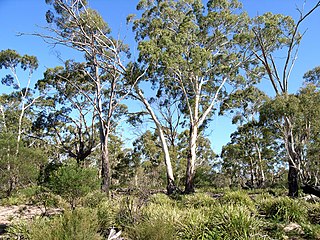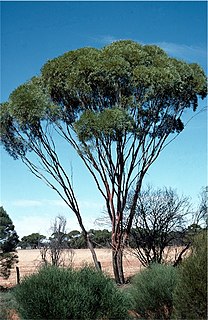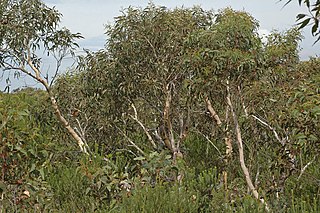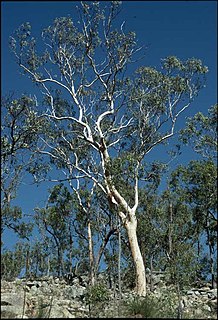
Eucalyptus viminalis, commonly known as the manna gum, white gum or ribbon gum, is a species of small to very tall tree that is endemic to south-eastern Australia. It has smooth bark, sometimes with rough bark near the base, lance-shaped to curved adult leaves, flower buds in groups of three or seven, white flowers and cup-shaped or hemispherical fruit.

Eucalyptus rudis, commonly known as flooded gum or moitch, is a species of small to medium-sized tree endemic to coastal areas near Perth, Western Australia. The Noongar names for the tree are colaille, gooloorto, koolert and moitch. This tree has rough, fibrous bark on the trunk and large branches, smooth greyish bark above, lance-shaped to curved adult leaves, flower buds in groups of between seven and eleven, white flowers and bell-shaped, cup-shaped or hemispherical fruit.

Eucalyptus leucoxylon, commonly known as yellow gum, blue gum or white ironbark, is a species of small to medium-sized tree that is endemic to south-eastern continental Australia. It has smooth yellowish bark with some rough bark near the base, lance-shaped or curved adult leaves, flower buds in groups of three and cylindrical, barrel-shaped or shortened spherical fruit. A widely cultivated species, it has white, red or pink flowers.

Eucalyptus rubida, commonly known as candlebark, ribbon gum or white gum, is a species of small to medium-sized tree that is endemic to south-eastern Australia. It has smooth bark, sometimes with rough bark at the base, lance-shaped or curved adult leaves, flower buds in groups of three, white flowers and cup-shaped, hemispherical or bell-shaped fruit.

Eucalyptus globulus subsp. bicostata, commonly known as the southern blue gum, eurabbie, blue gum or Victorian blue gum, is a subspecies of tree that is endemic to south-eastern Australia. It has mostly smooth bark with some persistent slabs of old bark at the base, juvenile leaves with one glaucous side, glossy, lance-shaped adult leaves, warty flower buds in groups of three, white flowers and hemispherical to conical fruit.

Eucalyptus kochii, commonly known as oil mallee, is a species of mallee, sometimes a tree, and is endemic to Western Australia. It has rough, flaky or fibrous bark on the trunk, smooth grey bark above, linear to narrow lance-shaped adult leaves, flower buds in groups of nine to fifteen, white flowers and urn-shaped fruit.

Eucalyptus flocktoniae, commonly known as merrit, is a species of tree or mallee that is endemic to Western Australia. It has smooth, silvery grey bark, lance-shaped to curved adult leaves, prominently beaked flower buds in groups of seven or nine and barrel-shaped or urn-shaped fruit.

Eucalyptus racemosa, commonly known as snappy gum or narrow-leaved scribbly gum, is a species of small to medium-sized tree that is endemic to eastern Australia. It has smooth, mottled bark, lance-shaped to curved or egg-shaped adult leaves, flower buds in groups of between seven and fifteen, white flowers and cup-shaped, conical or hemispherical fruit.

Eucalyptus loxophleba, commonly known as York gum, daarwet, goatta, twotta or yandee is a species of tree or mallee that is endemic to Western Australia. It has rough bark on the trunk, smooth olive to brownish bark above, lance-shaped adult leaves, flowers buds in groups of between seven and eleven, white flowers and conical fruit.

Eucalyptus pachycalyx, commonly known as the shiny-barked gum, is a species of tree that is endemic to north-eastern Australia. It has smooth, pale grey, mottled bark, lance-shaped or curved adult leaves, white flowers and cup-shaped or hemispherical fruit.
Eucalyptus phenax, commonly known as green dumosa mallee or white mallee, is a species of mallee that is endemic to southern Australia. It has smooth bark, lance-shaped adult leaves, flower buds in groups of seven or nine, white flowers and cup-shaped to cylindrical fruit.

Eucalyptus scyphocalyx, commonly known as goblet mallee, is a species of mallee that is endemic to southern areas of Western Australia. It has smooth bark, lance-shaped adult leaves, flower buds in groups of three or seven, creamy white flowers and cup-shaped to cylindrical fruit.

Eucalyptus striaticalyx, commonly known as Cue York gum or kopi gum, is a species of tree or mallee that is endemic to Western Australia. It has thick, rough, fibrous bark on the trunk and larger branches, lance-shaped adult leaves, flower buds in groups of between seven and thirteen, creamy white flowers and conical to cup-shaped fruit.
Eucalyptus subangusta is a species of tree, mallee or mallet that is endemic to the southwest of Western Australia. It has smooth bark, narrow lance-shaped leaves, flower buds in groups of up to nineteen, white flowers and cup-shaped to barrel-shaped fruit.

Eucalyptus celastroides, commonly known by the Noongar name of mirret, is a species of eucalypt that is endemic to the south-west of Western Australia. It is a mallee, rarely a tree, and has rough bark on about half of the lower half of its tunk, smooth above, narrow lance-shaped adult leaves, flower buds in groups of seven or nine, white flowers and urn-shaped fruit.

Eucalyptus conglobata, also known as the cong mallee or Port Lincoln mallee, is a species of eucalypt that is native to the south coast of Western Australia and South Australia. It is a mallee with smooth bark, lance-shaped adult leaves, flower buds in groups of seven, white flowers and clustered hemispherical fruit.
Eucalyptus tardecidens is a species of mallee or small tree that is endemic to north Queensland. It has rough, fibrous or flaky bark on the trunk and branches, lance-shaped adult leaves, flower buds in groups of seven, white flowers and shortened oval to cylindrical fruit.

Eucalyptus pauciflora subsp. niphophila, commonly known as snow gum, is a small tree or large shrub that is native to a few mountain peaks in eastern Australia. It has smooth bark, glossy green, lance-shaped to egg-shaped or elliptical leaves, flower buds in groups of between nine and fifteen, white flowers and cup-shaped, hemispherical or conical fruit. It differs from other subspecies of E. pauciflora in having more delicate, pedicellate flower buds and smaller leaves.

Eucalyptus pauciflora subsp. pauciflora, commonly known as snow gum, cabbage gum or white sally is a tree or mallee that is endemic to eastern Australia. It has smooth bark, glossy green, lance-shaped, curved or elliptical leaves, flower buds in groups of between nine and fifteen, white flowers and cup-shaped, hemispherical or conical fruit.

Eucalyptus socialis subsp. eucentrica, commonly known as the inland red mallee, is a subspecies of mallee that is endemic to inland Australia. It usually has rough bark on the base of the trunk, smooth bark above, lance-shaped adult leaves, flower buds in groups of between seven and eleven, pale creamy yellow flowers and barrel-shaped to urn-shaped or spherical fruit.



















